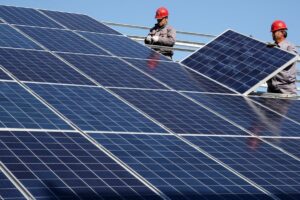
The rise in energy prices as a result of the conflict in the Middle East could weaken economic growth in the eurozone and thus smooth out inflation, said Luis de Guindos, deputy head of the European Central Bank (ECB).
“The emergence of the Iranian-Israeli conflict adds some uncertainty to the dynamics of oil prices,” The Wall Street Journal quoted him as saying. It is therefore important to keep a close eye on developments in the real economy as an indicator of inflation prospects.”
According to de Guindos, the increase in duties on European exports to the United States will certainly slow down inflation in the currency bloc, including because it will weaken economic growth.
“Higher duties are expected even if bilateral negotiations are successful,” the deputy head said. The ECB cut its key policy rate in June and made it clear that it was nearing the end of its monetary easing cycle. In May, inflation in the euro area was below the 2% target.
However, de Guindos’ comments suggest that the rate may have to be cut further to keep inflation around 2%, the WSJ writes.
Source: http://relocation.com.ua/rising-energy-prices-could-weaken-economic-growth-in-europe/

The Poltava Oil Extraction Plant (POEZ) of the Kernel agricultural holding has officially switched to renewable energy sources certified by the international organization Bureau Veritas Group, the company’s press service reported on Facebook.
According to the report, the agricultural holding will fully supply POEZ with renewable energy from sunflower husks, thereby reducing its dependence on fossil fuels and cutting greenhouse gas emissions by more than 11,000 tons per year. In addition, autonomous power generation will ensure continuity of production and reduce risks to food security.
“This is another step towards transforming Ukraine into a sustainable, energy-independent, and innovative country that knows how to turn agricultural resources into strategic advantages. Now our consumers can make an informed choice and contribute to the green recovery of the country’s economy by supporting a producer of certified sustainable oil,” Kernel emphasized.
It is specified that POEZ became the first company in Ukraine’s food sector to join the Science Based Targets Initiative (SBTi). In addition, it intends to support communities and supply surplus “green” energy to Ukraine’s power grid.
“This step is part of Kernel’s efforts to decarbonize and ensure climate resilience at every stage of our work: from the field to logistics,” the agricultural holding summarized.
The Poltava OEZ of the Kernel agricultural holding specializes in the production of sunflower oil under the Stozhar trademark. Previously, oil under this brand was produced in Vovchansk (Kharkiv region). With the start of the full-scale invasion of Ukraine by the Russian Federation, the work of the SEZ in Vovchansk was suspended and its capacities were transferred to the Poltava region. Before the war, the processing capacity of the Vovchansk SEZ was 330,000 tons of sunflower seeds per year. In turn, the Poltava SEZ is designed to process up to 430,000 tons of sunflower seeds per year and produces unrefined, refined, and hydrated vegetable oil, as well as meal.
Before the war, the Kernel agricultural holding company ranked first in the world in the production of sunflower oil (about 7% of world production) and its export (about 12%). It is one of the largest producers and sellers of bottled oil in Ukraine. In addition, it is engaged in the cultivation and sale of agricultural products.
In the first nine months of 2025, Kernel increased its net profit by 7% to $218 million, with revenue growing by 19% to $3.092 billion and EBITDA increasing by 4% to $398 million.

Since the beginning of 2025, the state-owned Oschadbank has signed loan agreements with large corporate businesses worth EUR 87 million for the implementation of energy projects, which is almost twice as much as in the whole of last year, according to a press release issued by the bank on Friday.
“While in 2024, 70% of the projects we financed were gas piston generation, in 2025, 50% of the projects will be energy storage facilities and 40% will be wind power generation,” said Yevhen Myachyn, director of the corporate business development and support department at Oschadbank, at the Energy Club forum ” Consumer-Oriented Energy System” in Kyiv.
According to him, the stabilization of the energy system, changes in gas prices and reserves have encouraged businesses to shift their focus to technologies that look more promising in the long term.
Oschadbank estimates its share of the energy loan market in Ukraine at 30% according to NBU statistics, which show that from June 1, 2024, to May 25, 2025, banks provided loans and opened limits for energy projects worth UAH 18.2 billion, or more than 705 MW of generation capacity.
“Oschadbank also continues to maintain its leading position in financing companies in the energy sector. According to the results of the first four months of 2025, Oschadbank’s share is 32%,” the state-owned financial institution emphasizes.
According to the National Bank of Ukraine, as of the beginning of 2025, Oschadbank ranked second in terms of total assets (UAH 963.39 billion, or 12.4%) among 61 banks in the country.

The Concorde Capital investment group plans to invest EUR120 million in energy projects by the end of this year and expects to build an energy company worth more than $1 billion in “a couple of years,” according to founder and owner Igor Mazepa.
“By the end of the year, we will invest EUR120 million. The market is a ‘blue ocean’ with no competition, so it’s just a matter of getting started. The IRR in this case is 35%, which means a return on investment in 2.5-3 years,” Mazepa said at the Forbes Money forum in Kyiv.
According to him, the market expects gas prices to rise and electricity prices to fall, but with a projected payback period of 2-3 years, investors will already feel more confident.
Mazepa noted that he first invested in the energy sector in August 2024, investing EUR 32 million in a pilot project, and is already seeing the first results of this investment, which confirm the correctness of this strategy.
In his opinion, such prospects are related to the fact that 10 GW of power capacity has been destroyed by the aggressor, and this is mainly maneuverable capacity, which is the most expensive and for which the market pays a premium price.
“There has never been such a price, not once, not in a single year that I can remember in the last 25 years.
It is even higher than in some Eastern European countries. It’s an amazing market, huge, worth billions of dollars!“ emphasized the owner of Concorde Capital, adding that gas and electricity prices are expected to rise further.
”I think that in a couple of years we will build just such a billion-dollar company in the energy sector,” he concluded.
As reported, Mazepa, with the help of four unnamed partners, acquired a 50 MW energy storage system for EUR 32 million in early 2025 and plans to then contract equipment for a gas-fired power plant worth EUR 30 million to create a single energy complex.
Alexei Timofeev, a member of the board of directors of BGV Group Management, who spoke alongside Mazepa, agreed that there are attractive investment opportunities in the energy sector, where the group has also accepted five projects – wind, batteries, gas cogeneration, and investments in the energy efficiency of utility networks through an energy service company. At the same time, he stressed that these are short-term and relatively small projects, and that this “hot” market is not about billions in investments.
“This is simply an illustration of the approach that exists, which does not work in the long term. Because it is impossible to make long-term forecasts based on peak prices without taking into account factors such as the return or non-return of the Zaporizhzhia Nuclear Power Plant, the restoration or non-restoration of coal-fired power generation… In general, when you jump above zero in three years, you can afford such things, but no billions will come here – there is nowhere to go,” the expert believes.
He added that Ukraine does not need to restore 10 GW of destroyed energy capacity because it does not have such a deficit. “Ukraine’s energy sector was in surplus before the war, and everything that has been destroyed is reflected in the fact that we have deindustrialization, loss of territory, and loss of population,” Timofeev said.

Schneider Electric, a leading global expert in energy management and automation, has unveiled a range of innovative solutions to address pressing energy and sustainability issues using artificial intelligence. The innovations were presented at the International Conference on Digital Transformation and Sustainable Development held in Paris.
Some solutions included innovations such as:
EcoStruxure Energy Hub – an intelligent energy management platform that allows companies to monitor resource consumption in real time and optimize their use to reduce their carbon footprint.
AI-Powered Grid Manager – an energy grid management system that uses artificial intelligence to analyze data and predictive control to improve the resilience and reliability of energy systems.
Green Building Suite – building optimization software to improve energy efficiency and reduce operating costs.
Smart Charging Station System for Electric Vehicles – a solution that integrates charging infrastructure with power grids and increases the efficiency of renewable energy sources.
According to Mikhail Bubnov, CEO of Schneider Electric Ukraine, these technologies will soon be available on the Ukrainian market.
“We are proud that our solutions presented in the global arena will be available to Ukrainian customers in the near future. This will enable the introduction of advanced technologies for energy management and automation, contributing to the sustainable development of the country and improving energy efficiency,” said Mikhail Bubnov.
According to the company’s forecasts, the use of such solutions in the Ukrainian market will contribute to improved energy management, cost reduction and transition to more environmentally friendly energy sources. This is especially important in the context of current challenges associated with the global energy crisis and the need to adapt to the standards of sustainable development.
Schneider Electric is a global leader in energy management and automation. The company develops integrated solutions for energy efficiency and sustainability, driving digital transformation across industries. With more than 180 years of history, Schneider Electric continues to innovate to create a sustainable future. Schneider Electric began its operations in Ukraine in 1994, opening representative offices in Kiev, followed by Donetsk, Mykolaiv and Lviv. In 2000, Schneider Electric Ukraine LLC was established with a commercial structure and warehouse, which allowed the company to strengthen its presence in the Ukrainian market and provide customers with a wide range of solutions in the field of energy management and automation.

PJSC Ukrnafta is working on implementing projects to generate energy from its own gas with a total capacity of up to 370 MW.
According to the company’s press release, this was announced by Duncan Nightingale, Chairman of the Supervisory Board of Ukrnafta, during the World Economic Forum in Davos.
He thanked the governments of Sweden, Norway, the Netherlands and the United States, as well as the European Bank for Reconstruction and Development (EBRD) for their support on the path to sustainable development and invited new partners to join the implementation of ambitious promising projects.
“We need to invest in Ukraine now. If you wait for the war to end, you may lose the most profitable projects,” Nightingale emphasized.
For his part, EBRD Vice President Matteo Patrone noted the positive financial results achieved by the company and improvements in the management system.
“They (Ukrnafta – IF-U) have demonstrated not only excellent financial results, but also true corporate governance. This is the achievement of Sergiy (Koretsky) and the Board. If two years ago I had been asked whether we would support Ukrnafta, I would have said no. But what has happened over the past 18 months is simply amazing,” he said.
“Ukrnafta is Ukraine’s largest oil producer and operator of a national network of filling stations. In March 2024, the company took over the management of Glusco’s assets and operates 547 filling stations – 462 owned and 85 managed.
The company is implementing a comprehensive program to restore operations and update the format of its filling stations. Since February 2023, the company has been issuing its own fuel coupons and NAFTAKarta cards, which are sold to legal entities and individuals through Ukrnafta-Postach LLC.
“Ukrnafta holds 92 special permits for commercial development of fields. It has 1832 oil and 154 gas production wells on its balance sheet.
Ukrnafta’s largest shareholder is Naftogaz of Ukraine with a 50%+1 share.
In November 2022, the Supreme Commander-in-Chief of the Armed Forces of Ukraine decided to transfer to the state a share of corporate rights of the company owned by private owners, which is currently managed by the Ministry of Defense.